Adobe Commerce is the eCommerce platform from Adobe that combines Magento Commerce and Adobe Commerce Cloud. It is Magento Open Source’s enterprise edition, which was formerly known as Magento Community. We’ll talk about the various features these two applications provide and respond to the following questions to assist you in selecting the digital commerce system that is best suited to your business’s requirements and objectives:
- What advantages does one solution have over another?
- If Adobe Commerce is built on the same platform as Magento Open Source, does it provide sufficient value to justify the additional investment?
- Is Adobe Commerce a better choice than Magento Open Source?
Magento Open Source
Magento Open Source is a self-hosted platform that lets you start from scratch and build an online store with all the basics of eCommerce. It comes equipped with the following features:
- Site Search
- Catalogue management
- Integrated checkout, payment, and shipping for instant purchases
- Mobile-optimized shopping
- Global selling
- WYSIWYG Page Builder
- Access to extensions through the Adobe Commerce (Magento) Marketplace
The software is open-source, which means that it is free to use and has a very active community that makes the platform—qualities that are also some of its greatest advantages. An eCommerce ecosystem that powers over 200,000 online stores, or roughly 10% of all eCommerce sites worldwide, is made possible by the collaborative efforts of a global community of developers to address a variety of use cases and business requirements.
Configuration and installation
The initial step in installing Magento Open Source is to configure your hosting and server. Any hosting service will work as long as the server meets the requirements of the Magento system. You are able to move on to installing Magento and getting started with your new eCommerce store once you have created a database on your host.
When setting up your online store, you can either use the default theme that comes with Magento or modify it. The process of setting up will be made easier if you buy a theme from a third party, but you can also make a theme from scratch.
Costs associated
With using Magento Open Source Although the platform itself is free, there are costs associated with hosting, extensions, themes, customizations, and so on. As previously stated, the solution includes numerous essential built-in features; however, establishing an eCommerce store that precisely meets a company’s requirements requires additional effort.
If you want more functionality without spending more money, the Adobe Commerce (Magento) Marketplace has a lot of free extensions that you can download and start using right away. The majority of businesses, on the other hand, purchase premium Magento extensions for the additional features, improved functionality, frequent updates, and dependable support. Typically, extensions are purchased to improve the store’s payment processing, content management, customer support, marketing, security, and optimization functions.
Mobile commerce
Magento Open Source has excellent mobile commerce features and functions. Themes based on a responsive web design and mobile-optimized shopping support are also included. Then there is PWA, or Progressive Web App, which is a web application that gives you both a mobile app and an eCommerce website!
Maintenance
If you have your own development team, you might be the only person responsible for maintaining your Magento Open Source eCommerce store. Alternatively, you can hire a Magento development company to take care of site maintenance on your behalf. In either case, it’s important to keep in mind that Magento Open Source is frequently updated, so your team or the agency you hire needs to be able to keep up. You can always get assistance from the Magento Community in resolving problems, but you cannot rely on it for support.
Scalability
Despite the fact that Magento Open Source provides all of the fundamental features needed to get your eCommerce store up and running, scalability is a major drawback. Due to the platform’s database limitations, you may outgrow it if your business expands rapidly. Because Magento Open Source only supports a single database system, if you have multiple websites and storefronts, your website might run slower.
Adobe Commerce
Adobe Commerce is an eCommerce solution with many of the same features as Magento Open Source, including the following:
- Live Search
- Business intelligence dashboards
- Visual Merchandising
- Customer segmentation
- Gift cards
- Advanced marketing tools
- B2B functionality tools for customer loyalty
The following Page Builder functions are only available to Adobe Commerce customers:
- Content staging and preview
- Dynamic blocks
- Native integration with product recommendations
Adobe Commerce on cloud infrastructure is a fully managed platform that comes with additional tools and support from Adobe, such as:
- Support for cloud onboarding
- Performance monitoring tools
- Improved security with Fastly WAF and DDoS services
- Cloud availability with an SLA of up to 99.99%
- Streamlined updates and testing
- Customer Success Manager
- Technical support
- Global availability
Adobe Experience Cloud
Adobe Commerce is offered as part of Adobe Experience Cloud, a collection of solutions designed to assist businesses in making informed decisions and providing enhanced customer experiences based on insights and data.
Applications and services for content and commerce, data and audiences, customer journeys, marketing workflow, and digital enrollment are all included in Adobe Experience Cloud products.
The platform that unifies the shopping experience across various channels is Adobe Commerce. It is compatible with Adobe Target, Adobe Analytics, and Adobe Experience Manager. Businesses can use Adobe Sensei’s machine learning and personalization capabilities as well as Adobe’s business intelligence services through Adobe Commerce.
Cloud infrastructure
Less expensive ongoing/maintenance costs, less expensive capital costs, faster time-to-market, improved scalability, and improved security are the primary reasons eCommerce businesses choose Adobe Commerce for cloud infrastructure.
Adobe Commerce is a platform-as-a-service (PaaS) that lets businesses quickly set up secure, scalable, and completely customizable eCommerce stores on cloud infrastructure hosted on AWS.
Security
The Fastly services that keep content delivery operations safe and optimized are included in the Adobe Commerce Cloud subscription.
- SSL/TLS certificates
- Origin cloaking
- Image optimization
- Content Delivery Network (CDN)
- Web Application Firewall (WAF)
- Distributed Denial of Service (DDoS) protection
Adobe Commerce is also a pre-certified PCI Level 1 infrastructure. Additionally, it includes integrated payment gateways that simplify Payment Card Industry (PCI) compliance by enabling businesses to transmit credit card data in a secure manner.
Integrated features
With drag-and-drop tools, integrated features, and the ability to quickly reposition text and images if necessary, Page Builder makes it simple to create content. You can experiment with the positioning of the message, visual effects, and other content components. You are still able to use widgets, blocks, and a media gallery from Magento, which means you can reuse your content in a variety of ways.
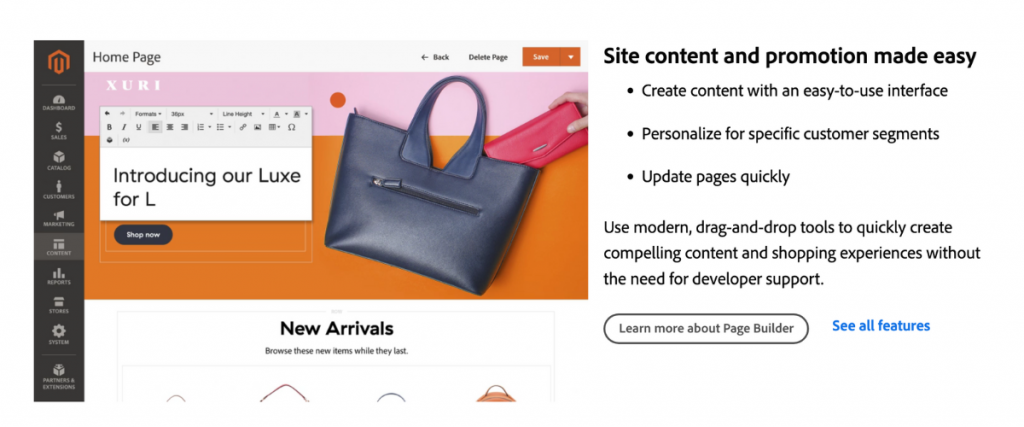
Using tools for inventory and order management, you can always keep accurate inventory. If you want to enter omnichannel retail and have multiple stores and warehouses, this is especially important. You can provide seamless customer experiences across all channels with real-time visibility of your product inventory. You can let customers order online and pick up their products in-store, or you can let them visit one of your physical stores and choose to have the products delivered to their home address.
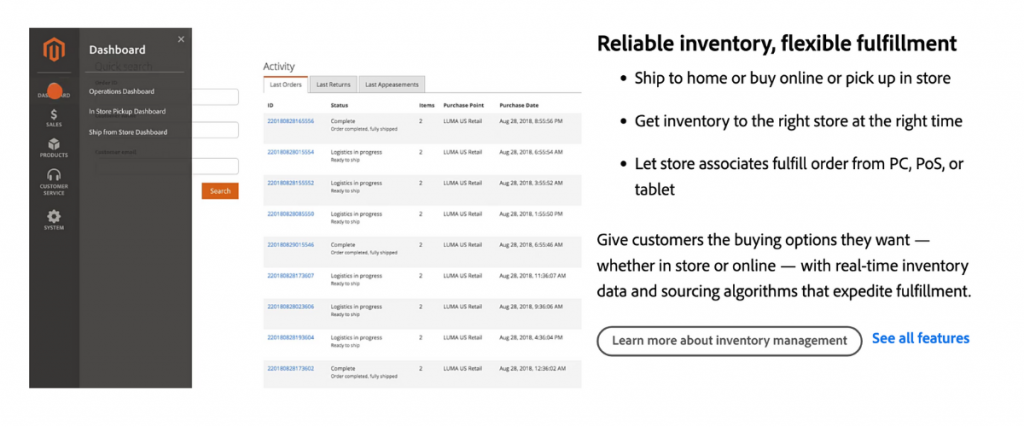
Adobe Commerce’s B2B capabilities are intended to make business-to-business purchasing as simple as possible for your clients. Adobe Commerce features like customer-specific pricing and catalogs, quick order forms, order and quote tracking, and self-service customer portals make it easier for your B2B customers to manage their orders.
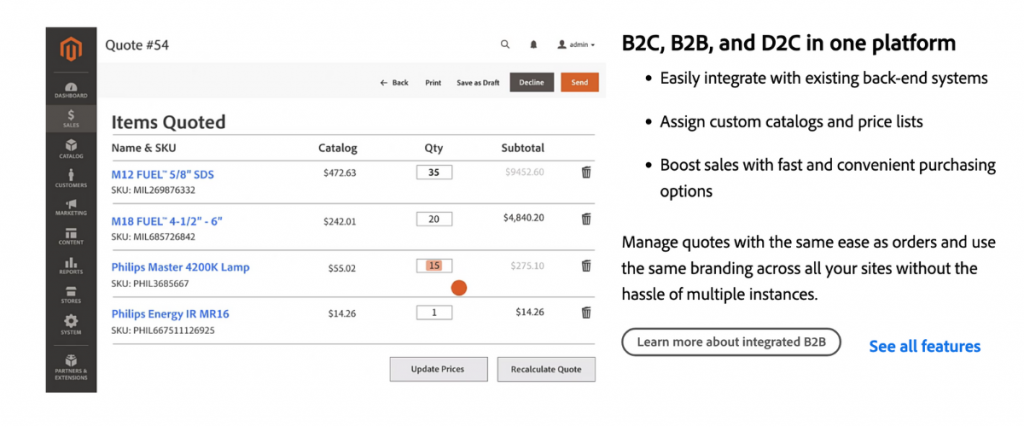
Adobe Commerce’s business intelligence includes robust visualization and powerful report-creation tools. View key metrics like customer lifetime value, retention rates, average order value, and other important ones on a dashboard so you can keep an eye on how your business is doing without having to deal with complicated reports that are hard to understand. During strategic planning and the creation of marketing campaigns, you can make more educated decisions with the assistance of insightful data about sales and customer behavior.
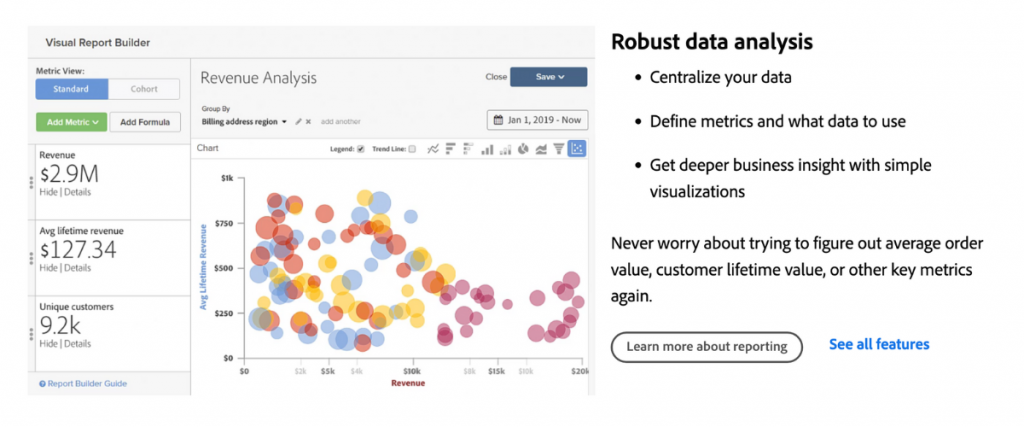
AI-powered functionality
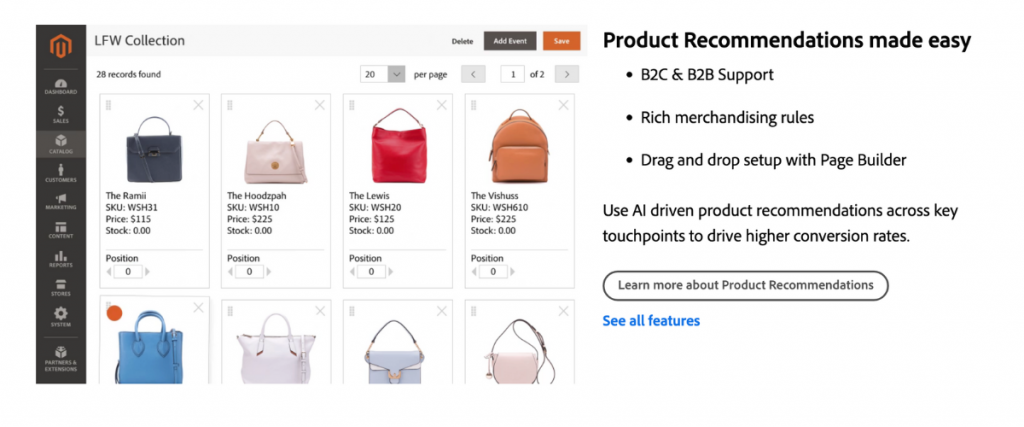
Adobe Sensei is an AI tool that supports the Adobe Experience Cloud’s AI-powered functionality. Bringing the power of artificial intelligence (AI) and machine learning (ML) to search, product recommendations, and merchandising, it seamlessly integrates with all of Adobe’s cloud services.
By combining Adobe Sensei with catalogue data, Adobe Commerce Live Search provides optimized results based on each user’s profile and previous actions.
Adobe Sensei’s product recommendations are personalized and intelligent. Merchants can also use tools to manage custom attribute support in recommendation rules and to define the scope of recommendations at the category level.
Sensei makes merchandising more intelligent and intuitive. Artificial intelligence (AI) uses performance data to automatically boost or deprioritize results or categories on dynamic digital shelves, which display products in accordance with predetermined rules and all relevant information about the website.
Adobe Target
Adobe Target is the testing, automation, and personalization solution from Adobe. Merchants and marketers can personalize and experiment with content and experiences through Adobe Target to boost revenue, conversions, and customer engagement at various touchpoints.
Automated personalization, auto-allocation, personalized insights reports, auto-target, and personalized recommendations are just a few of Adobe Sensei’s most innovative features.
Adobe Commerce Pricing
Pricing for Adobe Commerce The annual Gross Merchandise Value (GMV) and Average Order Value (AOV) serve as the foundation for pricing for Adobe Commerce. The annual subscription fee for a company with an average gross sales revenue of less than $1 million starts at $20,000.
Adobe Commerce Source versus Magento Open Source
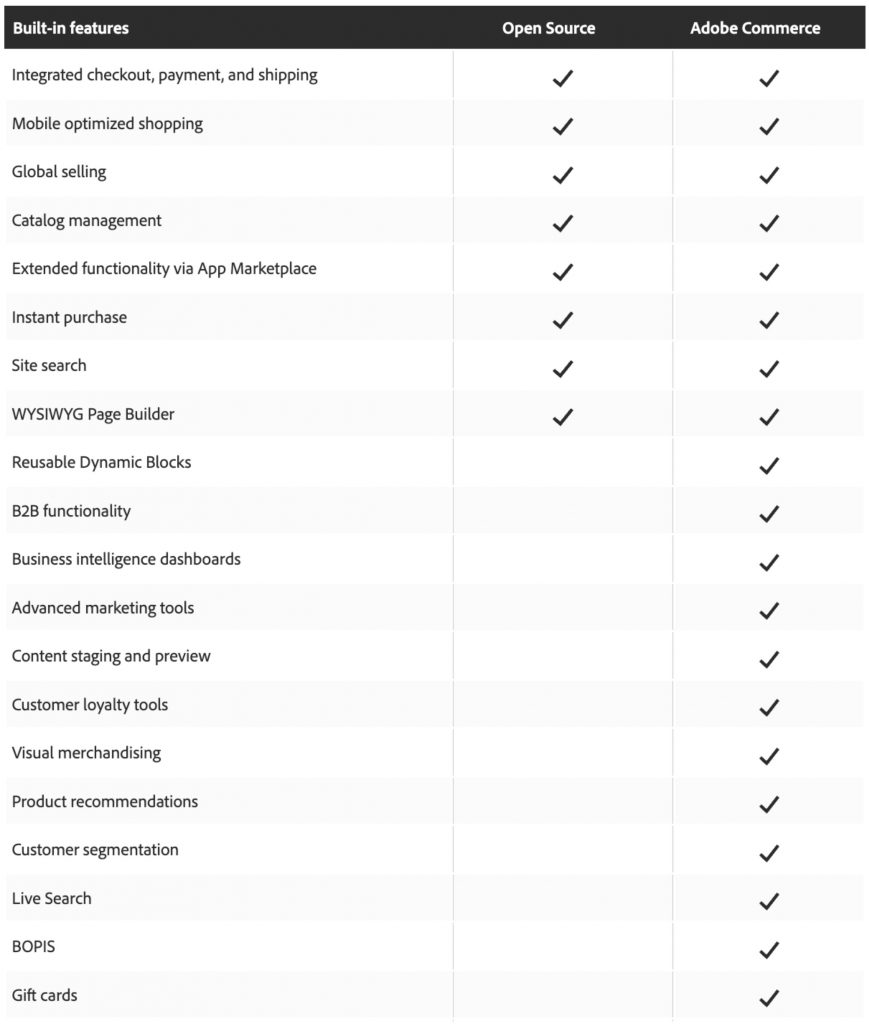
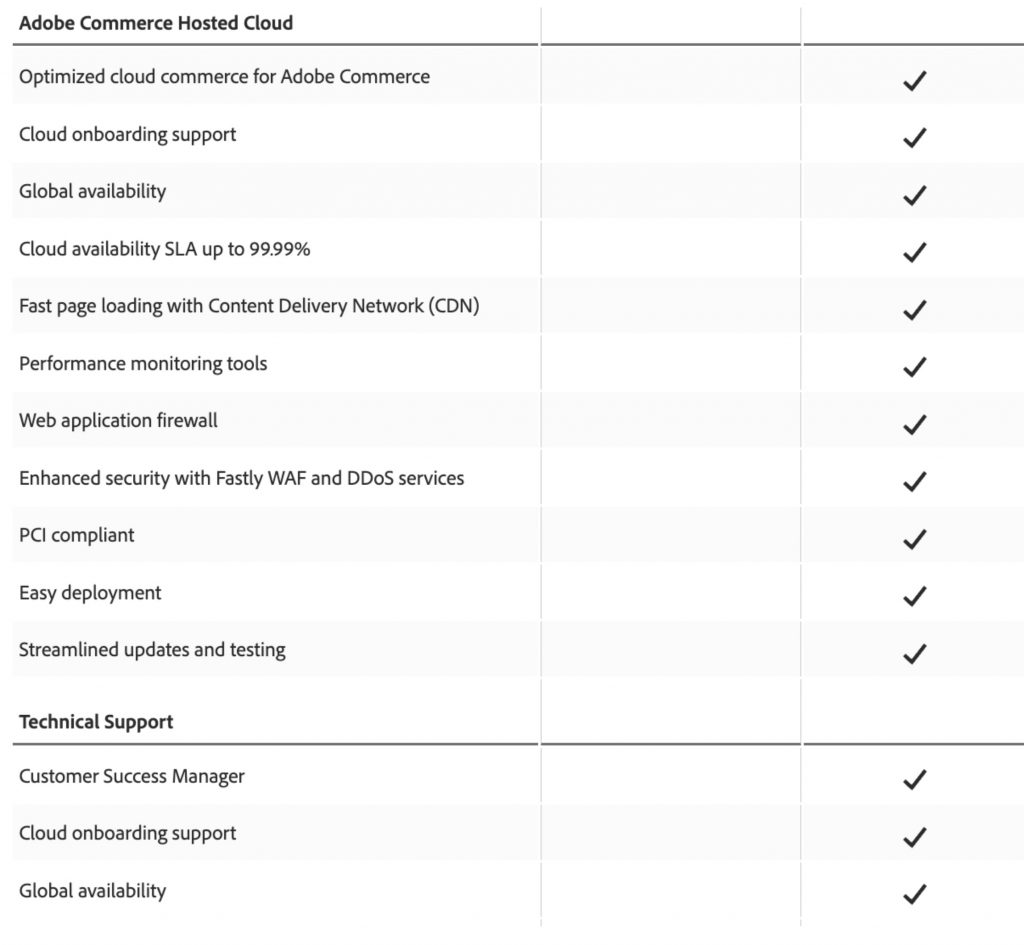
Magento Open Source is superior to Adobe Commerce primarily because the platform itself is free. Saving money on platform costs is a significant advantage that you should definitely take into consideration if you are just starting out or a small retailer.
The fact that the platform can be completely customized is what makes Magento Open Source even better. Many important eCommerce features that aren’t built into Adobe Commerce (Magento) Marketplace can be easily added with the help of the extensions available there. Additionally, because it is customizable and has features that can be extended, Magento Open Source is suitable for medium-sized businesses that require additional functionality.
Adobe Commerce, on the other hand, is the best choice for medium to large businesses that get a lot of traffic, have big plans for growth, and process a lot of orders every day.
Adobe Commerce’s advanced functionality, AI capabilities, elastic scalability, B2B features, and improved security give businesses a lot of room to grow. They also have the ability to improve the shopping experiences they give their customers at scales that Magento Open Source doesn’t. This means that conversions are much higher, revenue is much higher, and there are more opportunities to do well at multichannel fulfilment.
Consider upgrading to Adobe Commerce if you are using Magento Open Source and find that it no longer meets your requirements. Not only will you have a platform that is more scalable and secure, but you will also get a lot of advanced tools to help you run your business better, increase revenue, and give your customers a better overall experience.
Read this case study to learn more about how BUFF came to the decision to re-platform to Adobe Commerce on cloud infrastructure and what happened after the migration for more insight into when it might be time to move from Magento Open Source to Adobe Commerce.
The business value of moving to Adobe Commerce
A 2022 study for Adobe by International Data Corporation (IDC) looked at the advantages and value that businesses gained by moving from Magento Open Source to Adobe Commerce for managing and supporting their digital commerce operations.
11 businesses with 1 to 17,000 employees and annual revenues of $800,000 to $17 billion were interviewed for the study. The businesses, which had switched from Magento Open Source to Adobe Commerce, belonged to the following sectors:
- manufacturing,
- automotive/transportation,
- professional services,
- financial services,
- retail/wholesale
The only question you need to answer is whether your business still has room to grow with Magento Open Source or if you need to move to a more powerful platform to reach new heights of eCommerce success. With data backing up the benefits of upgrading to Adobe Commerce, there is a question that you need to settle. Whether your business still has room to grow with Magento Open Source, or if you need to move to a more powerful platform to reach new heights of eCommerce success. Average annual benefit of $45,000 per 10,000 transactions 516 per cent ROI in three years Improvements in several keys.
HMR One can be your growth partner. Whether you want to move from Magento Open Source to Adobe Commerce or build something new. We are well aware that just launching a platform does not guarantee success. Contact one of our e-commerce specialists right away to learn more about how HMR One can assist you in achieving your business objectives.



